Can you get a hamburger when traveling in India? Is it okay to eat beef on your India trip? Will you get thrown in jail or mobbed for eating a steak? My friends in Texas have asked. My family was curious about the beef situation here. And I had heard travelers discussing it, so I wondered as well…
Do people eat beef in India? Around 1 in every 13 Indians eats “beef.” Buffalo is also called beef in places where killing cows is illegal (24 out of 29 states). It’s a common and accepted dish in Kerala and Goa. In most places, it is not illegal to eat beef, yet it is socially unacceptable and not available.
The topic of eating beef is a highly charged one in India. In fact, if you’re traveling in India it would be safer not to bring up the topic of beef. In the same way, you would avoid controversial politics or religion (because the beef situation touches on both of these).
Disclaimer: I know beef is a sensitive subject for some people so if you are one, please stop reading. It is not my intent to offend anyone, only to inform someone who’s new to India and wanting to respect the culture.
I wanted to look more into this subject because I was getting questions from friends and family and I wasn’t sure how to answer them. I also wanted to understand the issue and help other travelers understand it, which is why I’m taking the time to write this.
In this post, we’ll cover how many people in India are eating beef, where are they eating it, and why wouldn’t they eat beef. We’ll also get into the recent beef ban and how it has impacted the issue.
How Many People Eat Beef in India?

Over 80 million Indian people eat beef. This includes 12.5 million Hindus. The National Sample Survey Office (NSSO) found this data in 2011-2012 by surveying 101,000 households, then extrapolating the data using population weights and other fancy statistical stuff 🤓
Important: Buffalo is also called ‘beef’ in many places. It may say beef on the menu, but what you’re actually getting is buffalo.
Here are some numbers about people eating beef, according to religion:
- 63.4 million Muslims eat beef/buffalo. 40% of the total Muslim population.
- 12.5 million Hindus eat beef/buffalo. 2% of the total Hindu population.
- 6.5 million Christians eat beef/buffalo. 26% of the total Christian population.
- 600,000 Buddhists eat beef/buffalo. 9% of the total Buddhist population.
- 280,000 other religions eat beef/buffalo. 13% of the total population from other religions.
Across the states of India you can find a variety of eating habits as well:
- Meghalaya – 94% of the population eats beef/buffalo.
- Lakshadweep – 78% of the population eats beef/buffalo.
- Sikkim – 72% of the population eats beef/buffalo.
- Nagaland – 57% of the population eats beef/buffalo.
- Uttar Pradesh – 47% of the population eats beef/buffalo.
- Maharashtra – 47% of the population eats beef/buffalo.
In North-East India, you will find a higher percentage of the population eats beef or buffalo meat.
In Southern states, you will find more Hindus eating beef/buffalo:
- Andhra Pradesh – 3.2 million
- Tamil Nadu – 3.1 million
- Kerala – 1.5 million
- Karnataka – 900,000
One note about the study is that all the data was ‘self-reported.’ Therefore, these numbers could be under-reporting how many people actually eat beef or buffalo.
In Hinduism, there is a lot of social pressure to NOT eat meat. In fact, anecdotal evidence suggests that you can actually find that beef is commonly served in some areas of Delhi. Or that it’s more commonly eaten than what you might think. Some chefs have said that eating it or talking about it is like a dirty little secret…
Most Americans and Westerns probably know that Hindus respect and revere cows. But why is that? And there’s a bit more to it that just ‘respecting cows’ so let’s dive into that now…
Why Do Hindus Respect Cows?
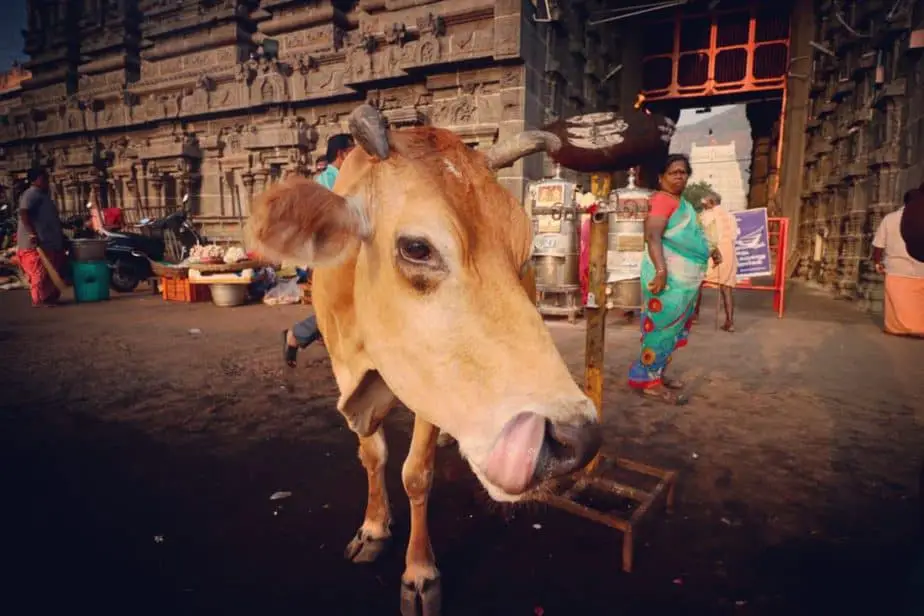
There are many reasons why Hindus love and respect cows. As a Westerner, I can’t claim to fully understand all the details. I know there are thousands of sects of Hinduism with their own unique perspective.
I hope to give you a general sense of the issue though, as I have spoken with local people about it and done research for hours into Hinduism. Here’s what I’m seeing from an outside perspective:
Cows are Kind

A main principle of Hinduism is to be kind and gentle to other people. A Hindu would NOT want to injure another person or intentionally harm them. Cows are an ideal symbol of this, and often seen as motherly. They are an ideal to be looked up to. Cows are thought to have a holy spirit, which makes them so peaceful.
Bhoomi is a Hindu goddess who is often shown as a cow and thought to live within each cow.
One of the most popular deities in Hinduism was Krishna. He was a cow herder. He’s often depicted in statues or architecture as playing the flute, or in paintings he’s blue. Sometimes he has four arms.
Cows are Valuable

Practically speaking, buying a cow is as expensive as buying a nice new car would be in the West. Cows are so important to the locals living in villages as well.
If you were to live in a village, your cow’s milk would provide milk to drink, yogurt and cheese to eat. If your crop died that year because there wasn’t any water (a common occurrence), then your cow could help keep your family alive.
Milk is considered pure and precious, having spiritual properties.
A cow’s dung is one of the least expensive and readily found forms of fuel as well. Instead of having to chop down trees, you can burn cow dung to make food and sustain your family.
Therefore cows are a good investment for a family. They’re not cheap either.
The price for a cow can vary wildly, but on the low end, you could easily pay 40,000 or 50,000 rupees. Or about $580 to $725 USD. Considering that the average household income in India is 1,13,000 rupees ($1639 USD) a cow costs almost half a year’s wage.
If you compare that to the average household income in the USA ~$61,000. That’d be like spending almost $27,000 on a cow. Or like an American buying a 2018 Ford Mustang!
Therefore, having a cow is a status symbol. If you can afford one, then you are looked up to by your community.
Eating Cows Causes Dullness
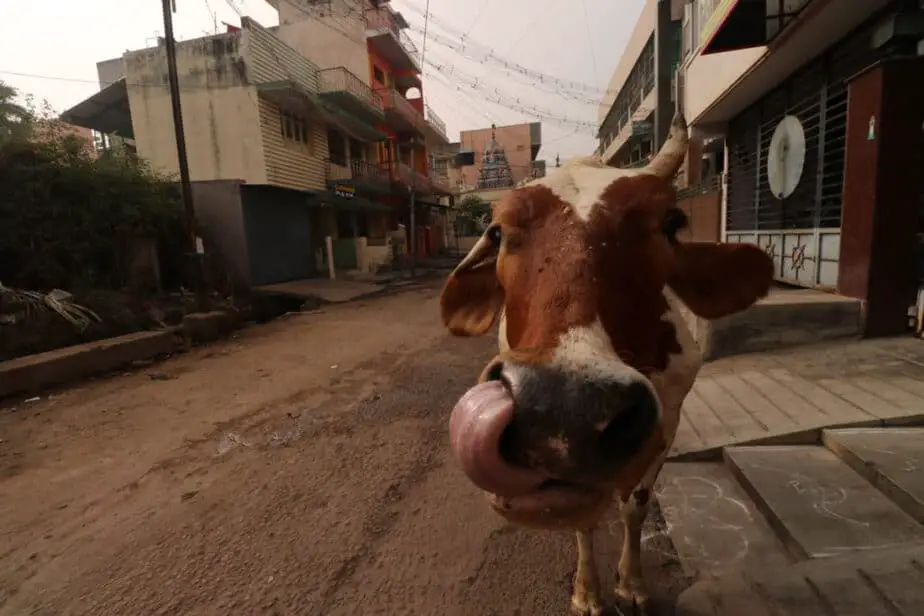
Finally, Hinduism food is grouped into three types. Based on your caste, you were expected to eat foods that would help you perform your daily duties.
Now the caste system has been abolished, everyone is equal, however, the underlying principles still have an influence.
I was unfamiliar with the specifics of the caste system until recently, but it works something like this…
The Four Main Castes in Hinduism:
- Brahman: The highest-ranking caste. It is the intellectuals, priests, teachers, political advisors… bloggers? 😉
- Kshatriyas: The warriors and politicians.
- Vaishyas: The merchants and farmers.
- Shudras: Workers. Meant to serve the other classes.
- Dalit: Not a part of the caste system, and often called the untouchables.
To help the castes know what to eat… Foods are grouped into three categories and are associated with different properties:
- Tamasic food: Heavy food that makes you feel sluggish. Meat, alcohol, even marijuana. Also, leftovers, frozen foods, and artificial foods would count.
- Rajasic food: Hot, dry, burning, sour, pungent and bitter foods that make you feel passionate. They stimulate your mind and body, yet could lead to aggression, egotism, and restlessness. Foods like chili peppers, chickpeas, chocolate, pickles, onions, sugar, wine, tea, coffee and garlic.
- Sattvic food: Fresh healthy foods that are associated with ascending. Foods that nourish you and help you keep a calm stable mind and sharpen your intellect. Foods like beans, whole grains, vegetables, milk, fruit, nuts, and seeds.
If you were a brahman priest, then you’d need a calm stable mind to do your best work, therefore you wouldn’t eat meat or drink alcohol. You’d eat more sattvic foods.
The data shows that families with higher household incomes are more likely to vegetarians in India.
It is a tradition for the lower castes to eat meat and beef. The workers or untouchables were eating it to survive.
Hindus Love Cows like Family

In the same way, my family loves their dog, I’ve heard it said that cows feel human emotions. They can tell when you’re sad and will try to make you feel better.
It reminds me of the way many people look at their pet dogs 🐶
We love them and treat them as family. We wouldn’t think of eating them cute adorable Fido. That’d be super weird and gross. In fact, I’d get angry if anyone tried to hurt my dog because I am so close to him.
For these reasons and some other political/religious reasons, there was a Beef Ban enacted a number of years ago that is still in effect in most states of India…
An Overview of the Beef Ban
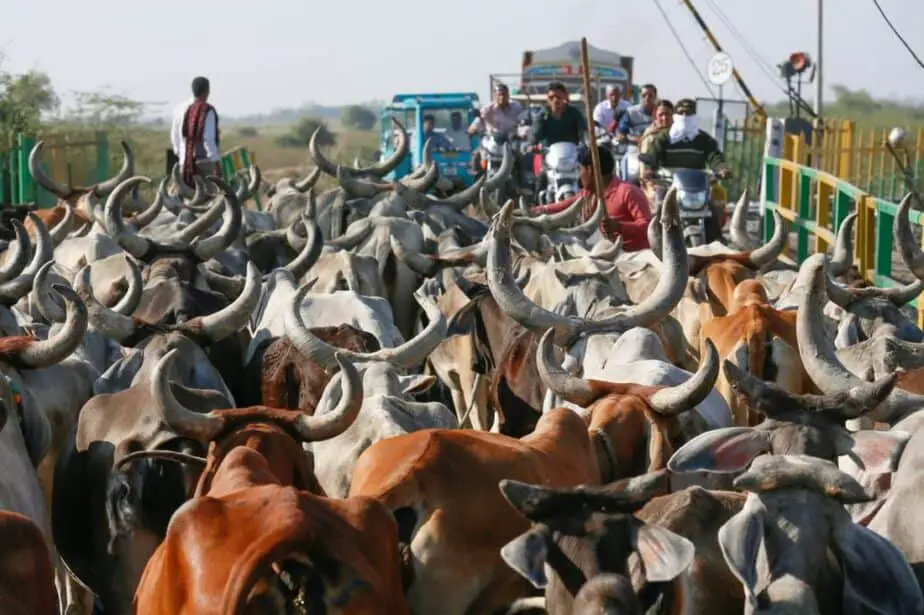
In May 2017, buying and selling cows to be slaughter was outlawed. While it has been difficult to enforce the ban, in general, beef is banned in most states and if you’re caught slaughtering a cow, then there can be stiff jail time.
In most places, it is NOT illegal to eat beef though.
As a foreigner and traveler, if you were, then you would not be punished. You may face some angry locals though, especially in areas where tensions are running high. Some people have been killed or beat up for having beef in their refrigerator at home.
In West Bengal, an area with a large number of Muslims who have always traditionally eaten beef, have had conflicts with local Hindus called “cow vigilantes” who are physically trying to stop them from killing cows. There have been 125 attacks made by the Hindus on the cattle traders since 2012. These attacks have led to other attacks which have resulted in 26 deaths in the past 2 years.
In general, do NOT eat beef in these states because their laws outlaw the slaughter and it would be socially taboo:
- Uttar Pradesh (where the Taj Mahal is)
- Rajasthan (Jaipur)
- Punjab (Amritsar)
- Odisha
- Maharashtra (Mumbai)
- Madhya Pradesh
- Karnataka (Bangalore)
- Jharkhand: Eating beef is illegal
- Jammu & Kashmir (Srinagar)
- Himachal Pradesh (Manali & Dharmashala)
- Haryana
- Gujarat: Proposed a life sentence as punishment for killing a cow.
- Delhi: You can eat buffalo though and it’s called beef.
- Chhattisgarh: Eating beef is illegal
- Bihar
- Assam
- Andhra Pradesh and Telangana (Hyderabad)
- West Bengal: Not illegal but it is controversial
You’re probably okay to eat beef discreetly here:
- Tamil Nadu (Chennai)
- Mizoram
- Nagaland
- Tripura
It’s acceptable to eat beef here:
- Kerala
- Goa
- Meghalaya
For the nerds, here’s a state-by-state rundown of the law and penalties:
Uttar Pradesh (North, where the Taj Mahal is)
You can NOT slaughter beef, ox or bullock. You can’t eat or store beef. If caught and convicted, you could serve seven years in jail or be fined 10,000 rupees.
It is legal to kill buffalo. You can also import beef using sealed containers to serve to travelers and foreigners.
Tamil Nadu (South East, major city is Chennai)
You can NOT slaughter cows or calves. If caught and convicted, you could serve up to three years in jail or be fined 1,000 rupees.
Eating beef is allowed.
Rajasthan (North, major city is Jaipur)
You can NOT slaughter bullock, bull, heifer, calf, or cow. You can NOT transport or possess their flesh. If caught and convicted, you could serve up to 10 years in jail or face a 10,000 rupee fine.
Punjab (North bordering Pakistan, major city is Amritsar)
You can NOT slaughter bullock, bull, oxen, heifer, cow or caves.
You can slaughter all types of cows for export though, with a government permit.
You can also serve imported beef.
Odisha (East along Bay of Bengay, major city is Puri)
You can NOT slaughter cows. If caught you could serve up to 2 years in prison or be fined 1,000 rupees.
You can kill old bulls and bullock if you have a fit-for-slaughter certificate. You can also kill a cow if it suffers from a contagious disease.
Mizoram (North East, major city is Aizawl)
There are no laws in place prohibiting cow slaughter.
Maharashtra (East, major city is Mumbai)
You can NOT slaughter bullock, bull or cow. If you are caught and convicted, you could serve 5 years in jail or receive a 10,000 rupee fine.
You can slaughter buffaloes.
Madhya Pradesh (Central, major city is Indore)
You can NOT slaughter cows or their offspring. If caught and convicted you could serve up to 7 years in jail.
One odd note: You are guilty, until proven innocent. You would need to prove you did not do it, or else…
You can slaughter buffaloes.
Karnataka (South West, major city is Bengaluru)
You can NOT slaughter cows, or transport them out of state to be slaughter.
You can slaughter old bulls and bullocks with a “fit-for-slaughter” certificate.
Possession of beef is not a crime.
Jharkhand (East, major city is Ranchi)
You can NOT consume or possess the meat of cows or oxen. You also can NOT slaughter them. If caught and convicted, you could face up to 10 years in jail or a 10,000 rupee fine.
Jammu & Kashmir (North, major city is Srinagar)
You can NOT possess the flesh of cows. This could land you a year in prison.
You can NOT slaughter cows or their offspring. If caught and convicted, you could spend up to 10 years in jail.
You can NOT slaughter a buffalo. If caught and convicted, you’d face a fine up to five times the animal’s price.
Himachal Pradesh (North, major destinations are Manali and Dharmashala)
You can NOT slaughter cows or buffaloes. If caught and convicted, you could face up to 5 years in prison.
You can kill cows in the interest of research or if they have a contagious disease.
Haryana (North, major city is Chandigarh)
You can NOT slaughter cows, calves, heifers, bullocks or bulls. You can NOT slaughter them even if they are barren, diseased or disabled.
You can NOT export cows to be slaughtered.
You can NOT sell beef products such as canned beef.
If caught or convicted, you could face 3 to 10 years in prison. Or face a fine of 1,00,000 rupees.
Gujarat (West, major city is Ahmedabad)
You can NOT slaughter cows of any type. You can NOT sell their meat. If caught and convicted, you could face up to 7 years in prison. Or you could face a 50,000 rupee fine.
It has been proposed to increase the punishment to a life sentence if you slaughter a cow!
Delhi
You can NOT slaughter “agricultural cattle” which means all types of cows like cows, calves, bulls and bullocks. You can NOT possess their flesh, even if you imported them into Delhi from somewhere else.
You can slaughter buffaloes.
You might see “beef” on the menu and that would be buffalo. However, there are places in Delhi, typically Muslim communities, where cow beef is served to locals, although I read it was very “hush hush.”
Chhattisgarh (Central East, major city is Raipur)
You can NOT eat, store or serve cow beef. You can also NOT eat buffalo, bullock or ox mean.
You can NOT slaughter cows as well.
Bihar (East, where the Buddha attained enlightenment under the Bodhi Tree)
You can NOT slaughter cows or calves. If caught and convicted, you would receive up to 6 months in prison or a 1,000 rupee fine.
You can kill bulls and bullocks older than 15 years.
Assam (West, major city is Guwahati)
You can NOT slaughter cows, unless they have a “fit-for-slaughter” certificate, or at designated places.
Andhra Pradesh and Telangana (South East, major city is Hyderabad)
You can NOT slaughter cows or calves. If caught and convicted, you would face up to 6 months in prison or a 1,000 rupee fine.
You can slaughter bulls and bullocks with a “fit-for-slaughter certificate. You could get a certificate if the animal is no longer able to breed or be used in farming.
Why can You Eat Beef in Kerala and Goa?
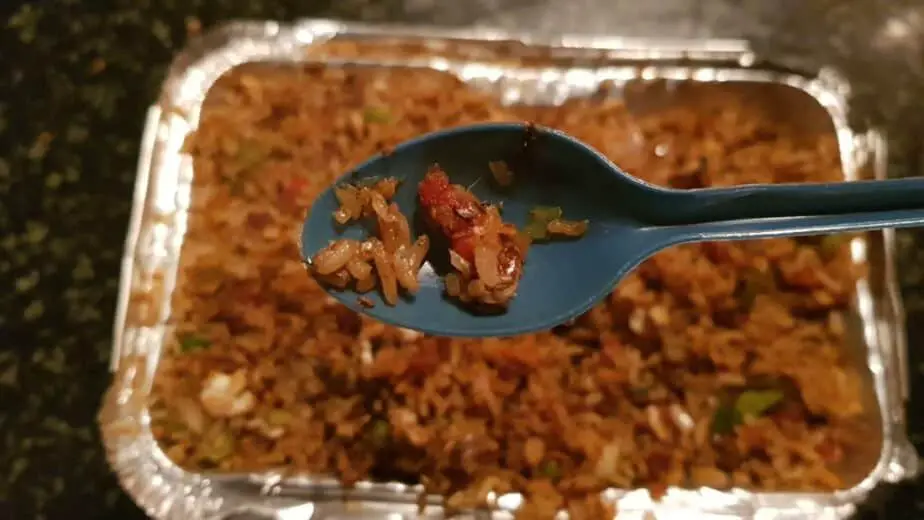
The main reason is that there are more Christians in these states. Now there are a lot of tourists and foreigners as well, which power the economy. And as they say, Money talks 🤑
Kerala has a long tradition of eating beef that goes back 2,000 years. Christian settlers introduced the dish and the very popular beef fry is still a modern staple.
27% of the population in Goa is Christian. It’s estimated the area gets almost a million tourists. AND like my friends back home who are asking about hamburgers, these tourists might enjoy a beef burger after a day on the beach.
What Do Indians and Travelers Eat Instead of Beef?
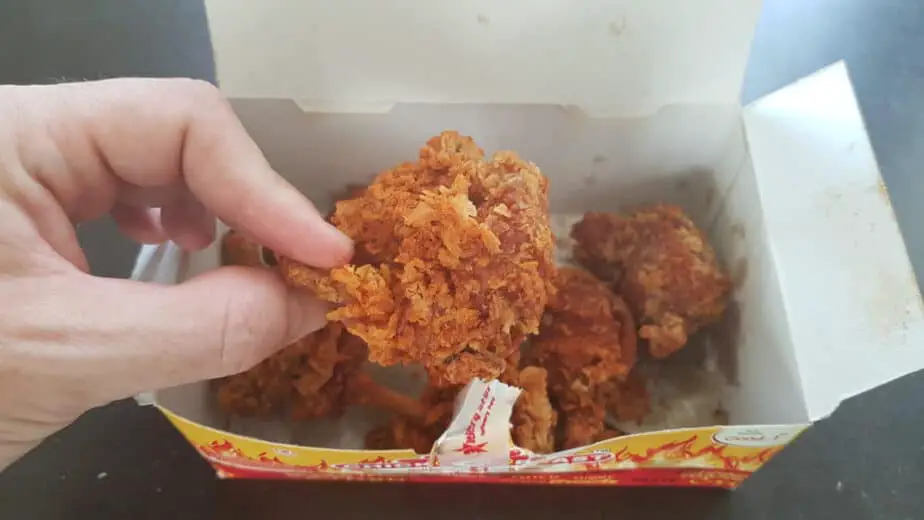
You can get burgers actually. They have chicken burgers. You can get veggie burgers.
McDonald’s serves the Maharaja Mac. Which is like the Big Mac, except with chicken patties for burgers. The sauce is different too. You won’t find the thousand island dressing inspired sauce, instead, there’s a habanero sauce.
Mutton and goat are also commonly found.
Fresh seafood is best along the coast in places like Goa, but you can find it everywhere.
Buffalo is really popular as a street food in places like Lucknow.
The food here is so good that I haven’t craved beef at all. In fact, when I renewed my tourist visa in Sri Lanka, I made sure to have some beef. Yet it was NOT as good as I thought. It was tough and a bit gamey.
Even in the USA, some of the beef you get is too chewy and not that good. I do like a delicious steak sometimes though, but the meat has to be top-quality.
Anyways, I would happily go without beef as I travel in India (I can eat masala dosa every night) however, as I was researching this post, I looked for beef dishes in my area.
I actually found some and ordered some beef fried rice.
After ordering it, I thought I would just take a look at the beef for myself, but it was making me sick thinking of it so I didn’t imagine I would eat it. Yet when the rice came, there were little bits of beef in there (if they were in fact beef) and the biryani rice was so delicious smelling, I quickly ate it down. It was pretty good too.
Related Questions:
What Happens if You Eat Beef in India?
Eating beef is illegal in the states Chhattisgarh and Jharkhand. In 24 of 29 states, the slaughter of cows is illegal, therefore it would be considered taboo to eat beef there. Riots have been started and people have been attacked for eating beef. It is likely that if someone saw you they might get angry or make rude comments.
In Kerala, Goa, and Meghalaya, eating beef is common so nothing would happen.
In general, eating beef is controversial in India. It strikes at the heart of a still-present rift between the Muslims (who eat beef) and the Hindus (who consider cows sacred). I’m not saying that this simply sums up the issue, but it is one of the main reasons for the strong feelings.
What Happens if You Kill a Cow in India?
If you slaughter a cow and are convicted, jail sentences range from a few months to up to 10 years. You could also face a fine of as little as 1,000 rupees to 50,000 rupees.
Do Muslims Eat Beef?
Yes. It is accepted in Islam to eat beef. It is NOT accepted to eat pork though.
Do Indians Eat Pork?
27% of Indians are vegetarian so they would not eat pork. The country is 80% Hindu, and pork is considered unclean so they would be less likely to eat it. 14% of India’s population is Muslim, who also consider pork unclean so would be less likely to eat it. Therefore, it is unlikely you will find much pork to eat here (sorry bacon lovers).
Does India Export Beef?
India is one of the largest exporters of beef in the world. However, this also includes buffalo. It would be illegal to export cow beef. India exported 1,850,000 metric tons in 2016 and was ranked fifth in the world.

